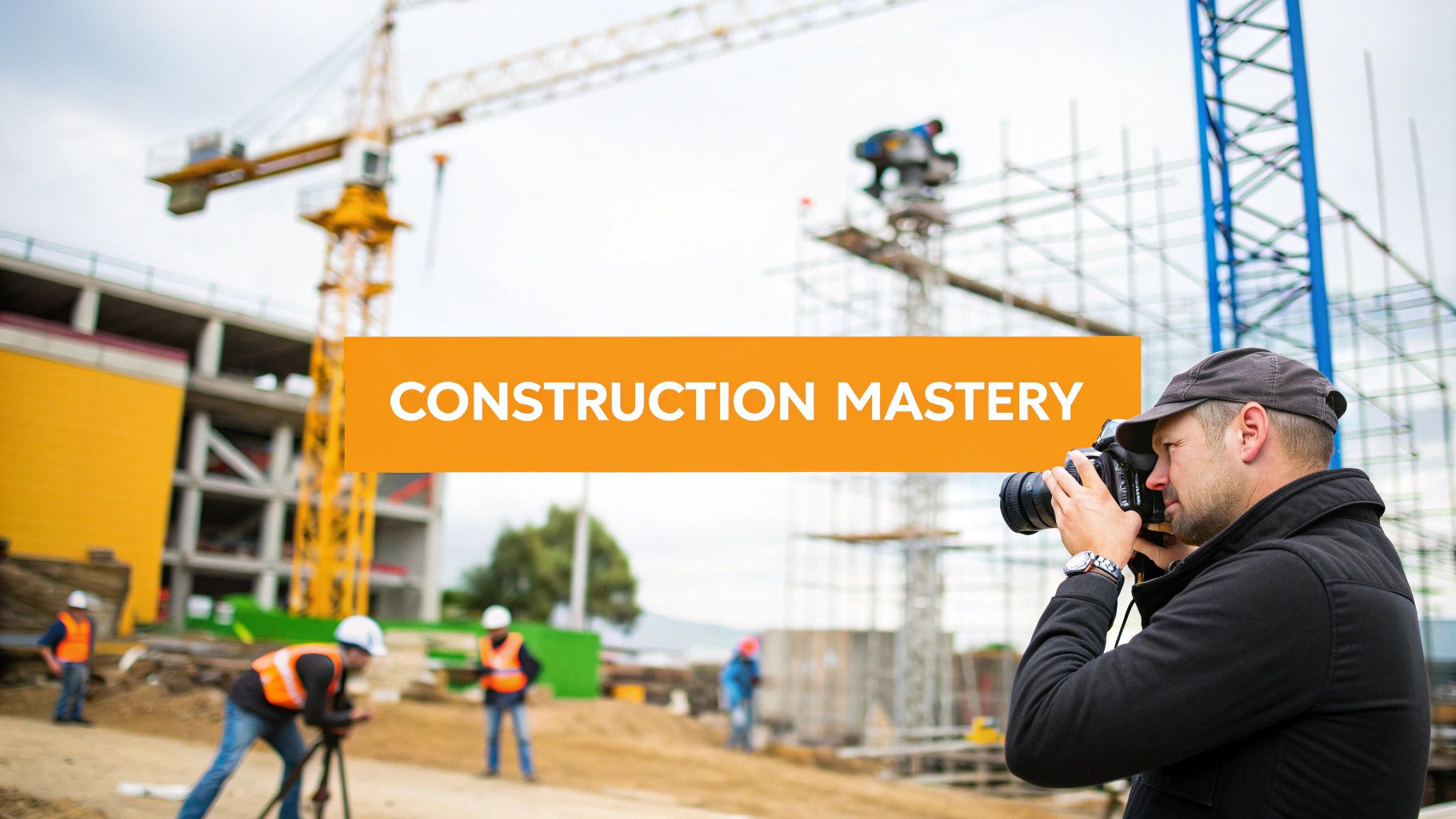

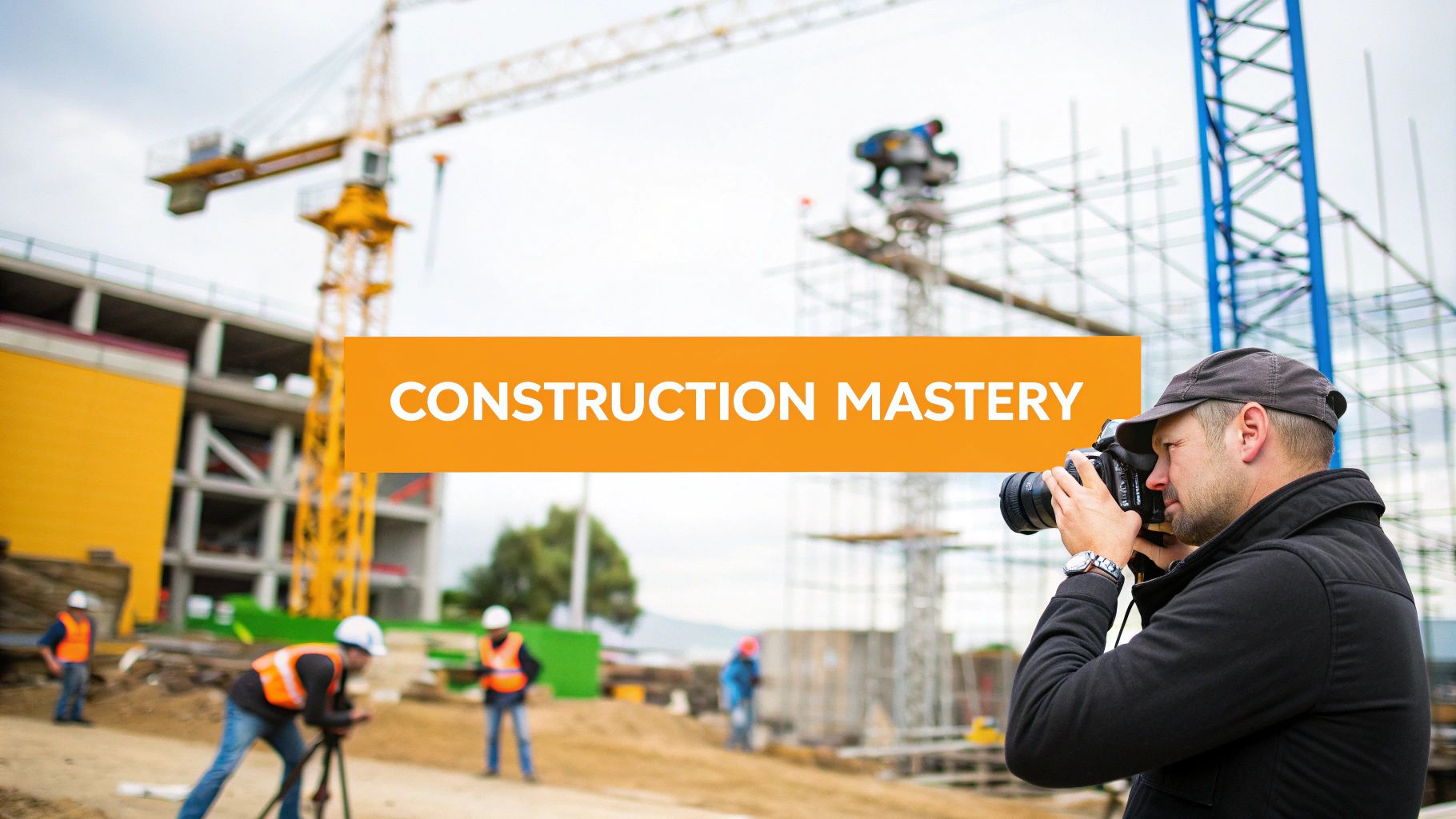
Forget those blurry phone snaps. They aren't winning you any new jobs. Professional construction photography isn't a nice-to-have; it's a core business tool. It’s your proof of quality, your record of compliance, and your best asset for convincing clients you’re the right choice.
In a competitive market, you need every edge. While your competitors rely on word-of-mouth, high-quality images give you a serious, tangible advantage. They are undeniable proof of your team's skill and attention to detail, building trust with potential clients before you even shake their hand.
Think about your last tender. Was it filled with sharp, compelling photos of a tricky foundation pour or a perfectly finished commercial fit-out in Tauranga? Or was it just a wall of text? Powerful images cut through the noise and make your proposal instantly more memorable and professional. They help you win more work.
Clients need to see what you can do, not just read about it. A strong portfolio of professional construction photography is your visual CV, showcasing your track record. It demonstrates pride in your work and shows you’re confident enough to put it on display.
A single, well-shot photo of a clean, organised work site says more about your professionalism than a page of text ever could. It’s an immediate signal of quality.
This kind of visual evidence is gold in an industry built on reputation. It reassures stakeholders, justifies your pricing, and gives potential clients the confidence they need to sign with you, not the other guy. It directly helps your company look professional and win work.
Beyond winning tenders, these photos fuel your marketing. They are the engine for your website, your social media, and your case studies, attracting new leads and building trust while you focus on the job at hand.
For builders and contractors in New Zealand, documenting project milestones is crucial. The construction sector is a huge part of our economy, contributing over NZD 17 billion to the GDP in recent years. High-quality imagery is essential for showcasing your role in this dynamic industry. Learn more about the NZ construction sector's economic impact.
Ultimately, investing in professional photography means building a library of assets that works for your business for years. For a deeper look at how other builders are using content to grow, check out more insights on our Onsite Media blog.
A great construction shoot is made long before the camera comes out. Getting it right comes down to a solid plan, not just showing up and hoping for the best. A bit of prep work ensures every minute on site is productive and the final photos actually help your business.
First, know why you’re taking photos. Are you documenting a critical milestone, like a concrete pour for a client update? Or are you capturing "hero shots" of a finished renovation for your website portfolio? Your goal dictates everything, from timing to the shot list.
When you know your purpose, you avoid wasting time. You leave the site with assets that will genuinely help you win more work.
Once your objective is clear, visit the site. Don't skip this. It’s essential for scouting the best angles, seeing how the light moves across the site, and spotting any safety issues ahead of time.
Walk the site with the site manager. Getting them on board is key to a smooth shoot that doesn't disrupt the project. The last thing you want is the photographer turning up during a toolbox talk or finding the perfect view blocked by a delivery truck.
A simple plan should cover:
This process gets everyone on the same page, making the shoot efficient and safe. A well-planned shoot respects the project timeline and delivers better results, helping you look more professional.
A clear plan turns a chaotic construction site into a controlled environment for your photographer. It’s the difference between random snapshots and strategic assets that win jobs.
This planning feeds directly into a simple, effective process for winning more tenders.
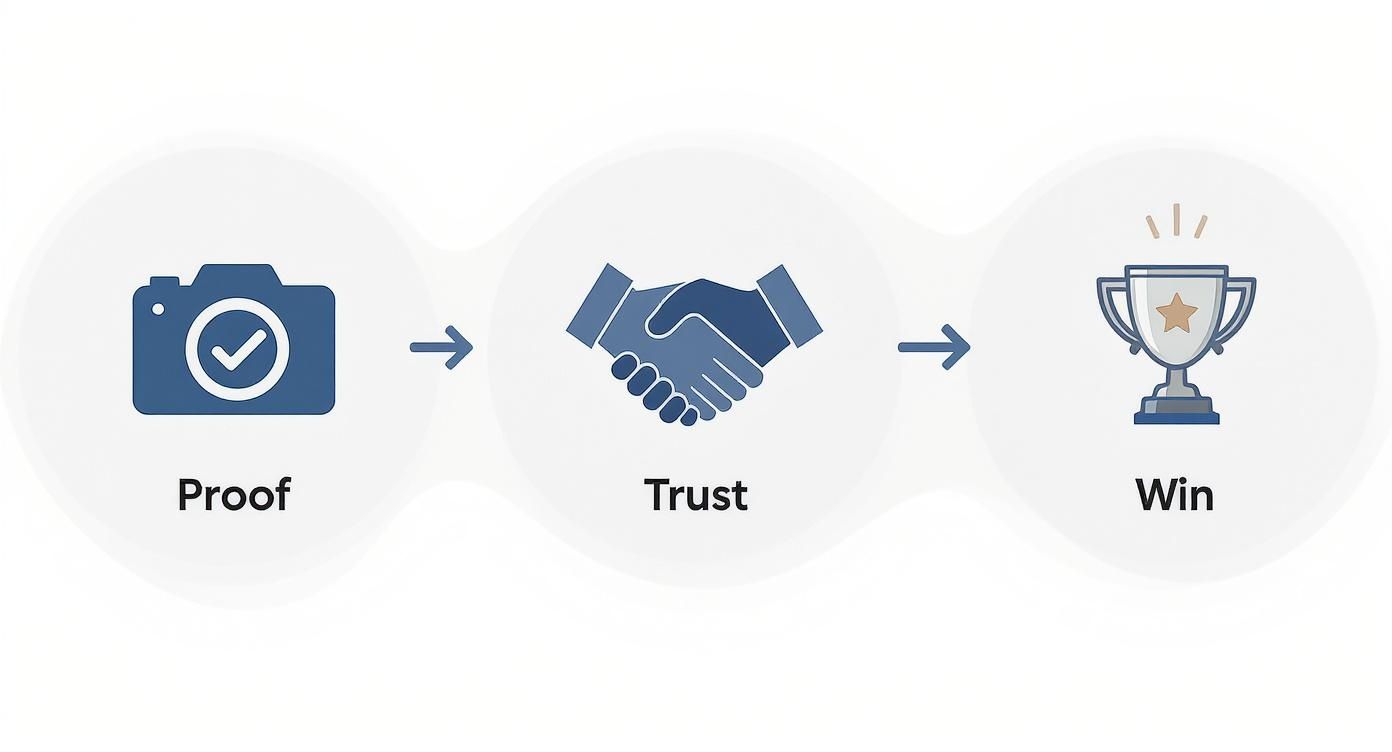
As you can see, there’s a direct line from capturing proof of your quality work to building client trust and winning the job.
Finally, bring your on-site team into the loop. A quick heads-up about when and where the photographer will be is all it takes. This gives them a chance to ensure the area is tidy, reflecting your company’s professional standards.
It’s a small step that makes a massive difference. A clean site with a team working professionally doesn't just look better on camera—it powerfully communicates the high standards you want to show future clients. If you're looking for more ideas on this, check out our guide on content creation strategies for builders.
This is how you turn a routine project into a compelling story about quality and craftsmanship that builds trust.
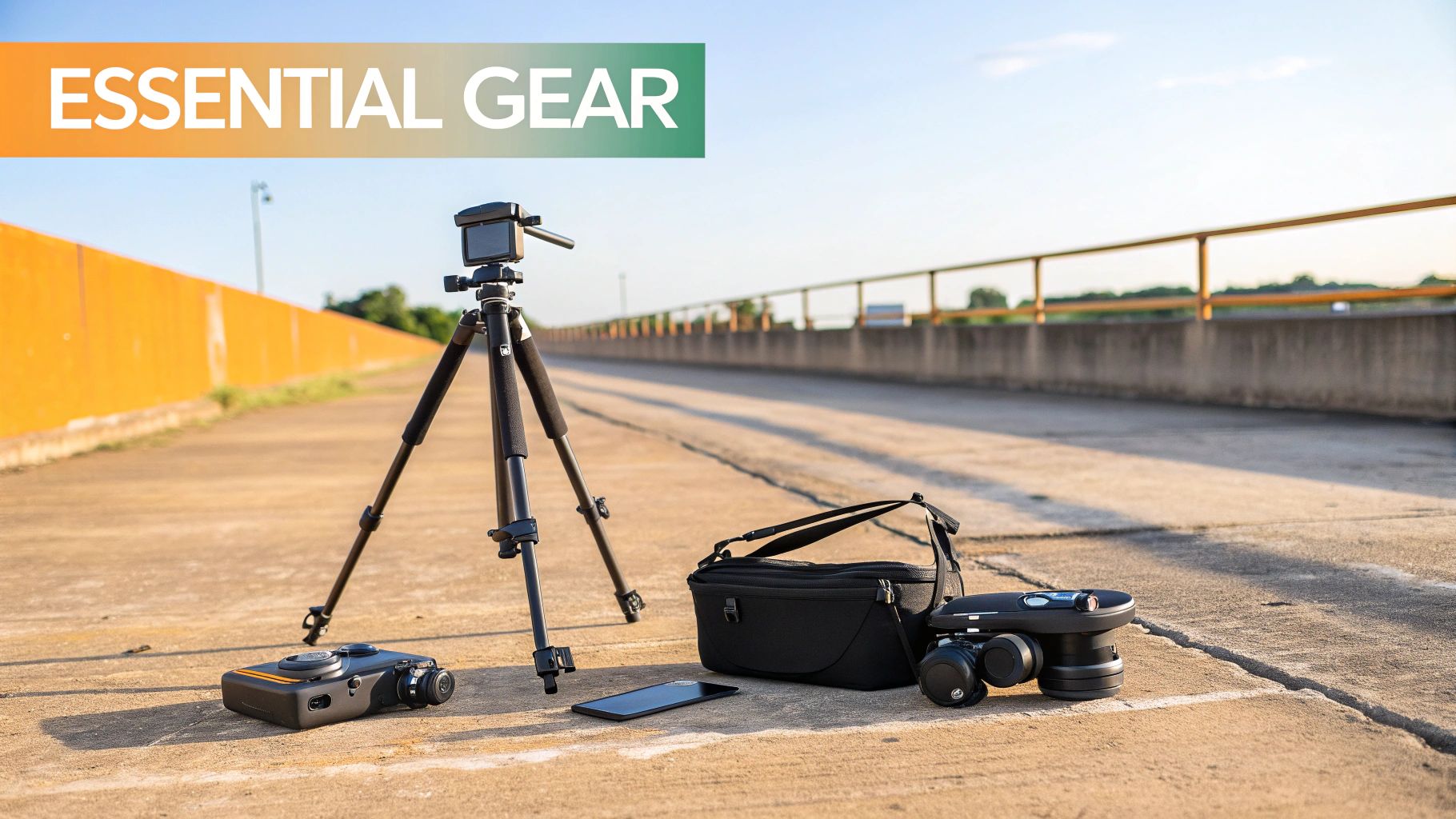
You don’t need a Hollywood budget, but professional construction photos require the right tools. A building site is a tough environment. Your gear needs to handle it while delivering sharp, compelling images that show off your work.
The camera body is the heart of the kit, but the lenses shape the shot. A quality wide-angle lens is non-negotiable. It’s the only way to capture the full scale of a project, whether you’re framing a sprawling foundation or the finished facade of a new build.
When your equipment is reliable, you can focus on framing the shot. An equipment failure on-site is a missed opportunity. That’s why investing in sturdy, dependable gear always pays off.
Here are the essentials:
The demand for high-quality visuals in New Zealand's construction sector has exploded. Firms now expect top-tier photography for everything from progress reports to marketing, proving their capability and professionalism.
Great gear is only half the battle. Knowing how to use it on a busy construction site is what separates average snapshots from powerful marketing assets. It’s about more than just pointing and shooting.
The real skill is seeing the story in the chaos. It’s finding the clean lines, the human element, and the moments of progress that communicate quality and skill.
Let's start with light. Harsh midday sun is your enemy—it creates ugly shadows and washes out details. Shoot early in the morning or later in the afternoon. Those "golden hours" give you soft, dramatic light that brings out the texture in concrete, timber, and steel.
Another key technique is to capture your team in action (safely, of course). Photos of your crew demonstrating their skills add a powerful human element that builds trust. These shots reveal the craftsmanship behind the build, turning an abstract project into a relatable story. This approach mixes the raw feel of construction with the polished look of a finished building, a topic we cover in our guide to architectural photography techniques.
Always try to frame your shots to tell a story of transformation, showing how raw materials are shaped into something extraordinary.
To ensure you never miss a critical shot, work from a checklist. This simple table covers the essential angles and moments to capture on any site.
Having a list like this helps you stay organised and ensures you walk away with a complete set of images that tell the project's story and help you win work.
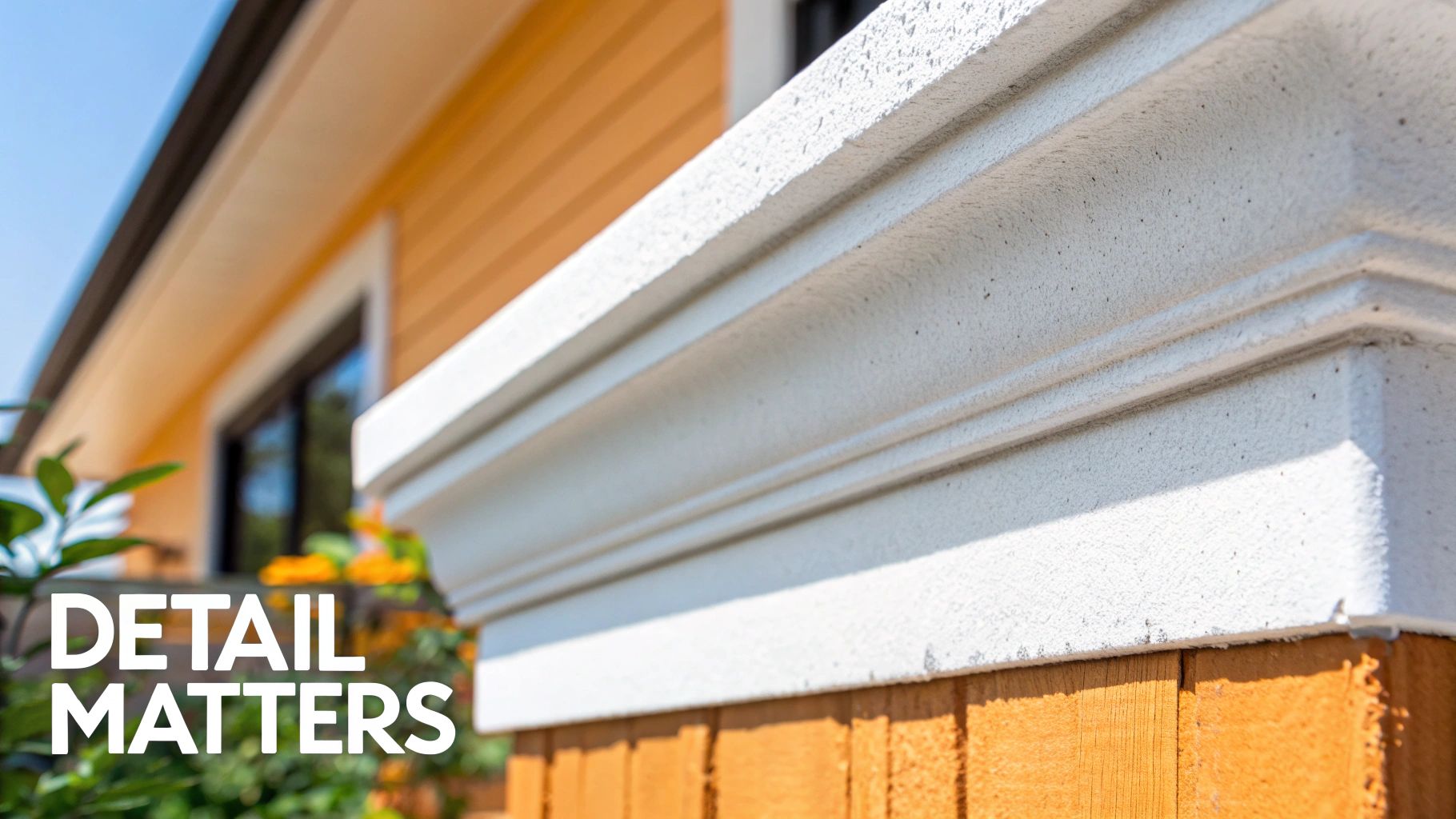
Wide shots show the scale of a project, but detail shots sell your quality. This is where you prove your craftsmanship and justify your price to a potential client.
These are the close-up images that stop people from scrolling. They offer undeniable proof of your high standards and communicate precision in a way big-picture views can't.
It’s about learning to see your site like a photographer—honing in on the small things that signal quality. These are the photos that build solid confidence in your abilities.
Think about the moments on site that reflect your team’s skill. A perfectly straight line of framing, a flawless skim coat on a wall, or a seamless join in custom cabinetry. These aren't just details; they're powerful visual statements that tell a client you don't cut corners.
Light is your best friend here. Light raking across a surface can highlight the texture of timber grain or the smoothness of finished concrete. This technique makes the materials feel tangible, helping a client imagine the quality of the finished space.
Good detail shots should focus on:
These are the images that separate you from the pack. They show you’re not just another builder; you’re a craftsperson who takes pride in their work. This helps you look professional and win the right kind of projects.
Your portfolio of detail shots is your visual argument for why you're worth the investment. Each image proves your commitment to excellence, making your value clear before you even submit a quote.
Even a close-up needs good composition. Don’t just point the camera at a screw. Think about how to frame the shot to create balance and focus.
Use leading lines—like the edge of a benchtop or a grout line—to guide the viewer’s eye to the key detail you want them to see.
Imagine you're photographing a new kitchen from a coastal renovation in Tauranga. A wide shot shows the whole space. But a tight shot on the dovetail joints of a drawer proves the quality of the joinery. Or a photo framing a perfectly installed window with a view of the coast tells a story of quality meeting location.
The human brain processes images 60,000 times faster than text. A potential client will feel the quality in a well-composed detail shot almost instantly.
These are the images that stick in their memory. They build trust, demonstrate skill, and ultimately, help you win the work you want.
So you've got a hard drive full of great construction photos. That's a good start, but it's just a start. Those images are useless until you put them to work.
Real value is unlocked when you turn those assets into business growth. This is where your investment in photography starts paying for itself.
Every photo needs a job. Whether it’s proving your quality in a tender or catching a client's eye on social media, your images need a clear purpose. Get them out of a forgotten folder and onto the front lines of your marketing. This is how you win more and better jobs.
Think of your website as your digital showroom. It needs to be packed with your best work. High-quality images are the most effective way to show clients the calibre of projects you deliver.
Build detailed case studies for your key projects. Don't just dump photos in a gallery. Pair your best shots—from sweeping wide-angles to tight close-ups—with a brief story about the project. Explain the challenges you solved and the quality you delivered. That combination of strong visuals and clear storytelling builds trust instantly.
Your website portfolio isn’t just a gallery; it’s your most powerful sales tool. It works 24/7 to prove your expertise, justify your value, and convince clients you're the right choice.
We’ve all seen those text-heavy, dry tender submissions. In a competitive process, professional images make your proposal stand out. Use photos to visually demonstrate your capabilities and past successes. A single shot of a clean, well-organised site says more than a page of promises.
Social media is another place to put your photos to work. Share behind-the-scenes progress shots on Instagram or LinkedIn to keep your audience engaged. These updates don't just showcase your active projects; they build a community around your brand and keep you top-of-mind for future work.
Here in New Zealand, the leading construction companies are all over this. They use high-quality photography for everything from marketing to tender documents. As projects get more complex, professional imagery has become a vital tool for demonstrating capability and winning work.
To make your photos work for you, you have to be able to find them. A disorganised photo library is a wasted asset. The solution is a simple, logical folder structure.
Set up a system that makes sense for your business:
[Project_Name_Client] > [Stage_of_Build] (e.g., Tauranga_Coastal_Reno > Framing)[Year] > [Month] > [Project_Name] (e.g., 2024 > 08_August > Smith_House_Handover)[Hero_Shots], [Detail_Shots], [Team_Photos]This small bit of discipline means you can find the perfect shot for a last-minute social post or a looming tender deadline.
Finally, to make sure your photos are driving results, you need to measure the marketing ROI of your visual campaigns. By tracking performance, you can refine your strategy and double down on what works, turning great photos into measurable business growth.
You’ve got questions. That’s a good place to start. Asking the right questions is the first step toward getting photography that actually makes a difference to your business. We get a lot of queries from builders, so here are some straight-up answers to the most common ones.
There’s no magic number. A good rule is to capture the key milestones.
For a long-term new build, that means getting a photographer on site for the big moments: the foundation pour, framing up, the weathertight lock-up stage, and the final handover. This gives you a powerful visual story of progress—perfect for client updates and for your marketing later.
For a shorter job, like a kitchen reno, a single, well-done shoot at the end is probably all you need. The goal is always the same: capture the stages that best show off your skill and the project's transformation. This helps you build a library of assets to win future work.
Simple. Think of it as process versus product.
Construction Photography: This is about the build in action. It’s gritty, dynamic, and shows your team at work, the raw materials, and the structure taking shape. It documents the skill and hard work that goes into the job.
Architectural Photography: This focuses on the finished product. It’s about clean lines, perfect lighting, and showcasing the space as a completed design. This style is polished, precise, and sells the final result.
You need both to tell the full story. One proves how you build, and the other shows off the stunning result.
Your phone is fine for quick, informal updates to the office or a subbie. But for anything a potential client will see, it just doesn’t cut it.
Putting phone photos on your website or in a tender makes a high-end building company look amateur, fast. It undermines the professional image you want to project.
A professional uses high-resolution cameras and specific lenses to control light and perspective in a way a phone can't. The result is sharp, compelling images that communicate quality and help justify your price.
The difference isn't a small detail; it directly shapes how potential clients see your brand. A professional photo says you're a professional outfit.
Safety is number one. No exceptions.
Any professional construction photographer will turn up with their own PPE and be familiar with site protocols. They must complete your site induction before they pick up a camera, just like any other contractor.
While working, they should be escorted by a site manager or another team member. This ensures they are guided safely through active work zones. A good photographer knows how to get the shot without getting in the way or compromising the safety of your crew.
Ready to show up online as good as you do on site? Onsite Media helps builders across New Zealand turn their craftsmanship into powerful marketing assets with high-end photography and video.
Book a free strategy call today to see how we can help you win better projects.
